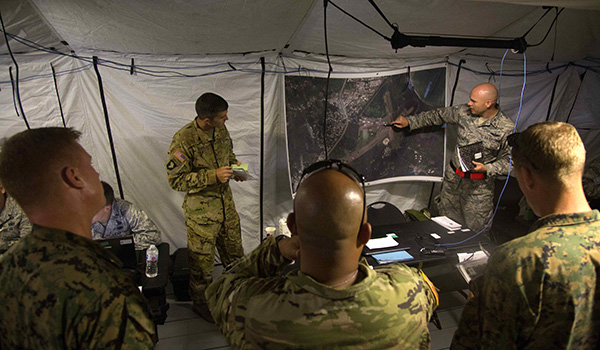
CWOB / By CW5 Joseph B. Roland: Today’s operational environments (OE) see consistent utilization of non-organic multi-functional aviation task forces (MFATFs) and blended combat aviation brigades (CABs).

U.S. Army MAJ Kurtis P. Evick (left), with the 101st Combat Aviation Brigade (CAB), attends a joint coordination meeting with FEMA, Air Force, and Marine Corps, at Ceiba, Puerto Rico, Sept. 28, 2017. The 101st CAB conducted medical evacuation and relief efforts to support FEMA in the recovery process of Puerto Rico after the devastation created by Hurricane Maria. / U.S. ARMY PHOTO SSG PABLO N. PIEDRA
Each of these units utilizes a tactical standard operating procedure (TACSOP) in one form or another; unfortunately no two are the same. These SOP variations and nuances increase crewmember progression time, erode crewmember primacy, and lead to training and organizational inefficiencies. Utilization of individual TACSOPs has led to an underutilization of doctrine and reliance on non-doctrinal documents. In other words they: “Frag, not Defrag our Hard drives.”
Based on AARs from our combat training centers (CTCs), redeploying CABs, and rotational units, the Aviation Branch has tasked the Directorate of Training and Doctrine (DOTD) to develop an all compo Universal Battle Book for use throughout our enterprise. In a parallel effort the Combat Readiness Center (CRC) is reviewing the standardization of the Risk Assessment Worksheet (RAW) and Aviation Fighter Management Programs. Our goal is to present a base document for review at the 2018 Aviation Senior Leader Forum.
The goal is to produce a Battle Book on how we fight, not a 400+ page TACSOP that covers everything from TOC setup to casualty notification. This Battle Book would cover basic warfighting blocking and tackling and could integrate as a universal appendix to an all-encompassing TACSOP. A standardized battle book will lead to efficiencies in unit and crewmember progressions, evaluations, train-ups, relief in place transitions, and non-organic unit integrations. Standardization allows for DES, ARMS, MCTPs, and our CTCs to utilize a common readiness assessment metric. Standardized mission briefs, AARs, brevity words, light signals, commo checks, doctrinal terminology, and mission contingencies could be integrated into initial flight training giving our aviators relevant repetitions prior to arriving at their first operational assignment.
A standardized Battle Book would facilitate the shared understanding with the ground forces we are ultimately responsible for. Each BCT and IBCT habitually trains aviation operations at home station utilizing their Divisional CAB’s TACSOP. While that type of training and team building works when deployed with your organic ground/air assets, when was the last time you deployed and fought that way? A standardized aviation battle book based on doctrine, common terms and procedures provides our ground commanders a format which facilitates rapid integration and complex mission execution. Being ready to fight tonight doesn’t leave much time to relearn unit unique warfighting standards.
Some say that a universal Battle Book would lead to complacency and stifle innovation, I disagree. We are talking about standardizing basic aviation mission fundamentals; unique mission situations still require initiative and ingenuity. With limited resources and manpower and a requirement to be ready tonight we can’t afford to waste time relearning fundamentals just placate someone’s desire to put their personal stamp on something. I do not consider changing a flight ready signal, in-flight join-up brevity, or commo check procedure to be either innovative or ingenious. Just remember each of us is one PCS from welcoming a universal standardized Battle Book.
We’ve been tasked to “Win in a Complex World”; this requires readiness for the unknown, unknowable and constantly changing. In order to prepare for this ambiguous task we must first master the fundamentals of our profession and be doctrinally competent. Standardizing basic aviation warfighting and mission execution fundamentals will enable timely and seamless ground integration. Providing multiple dilemmas to our advisories and options for our commanders requires innovation, initiative, and a defragged hard drive; this initiative is just a small step in getting us there.
“Above the Best!”
CW5 Joseph B. Roland is the chief warrant officer of the Aviation Branch with the U.S. Army Aviation Center of Excellence, Fort Rucker, AL. COL Joe Degliuomini, director of DOTD, and CW5 Jason Watson, 10th CAB/TF Falcon Aviation Mission Survivability Officer, provided input.





















